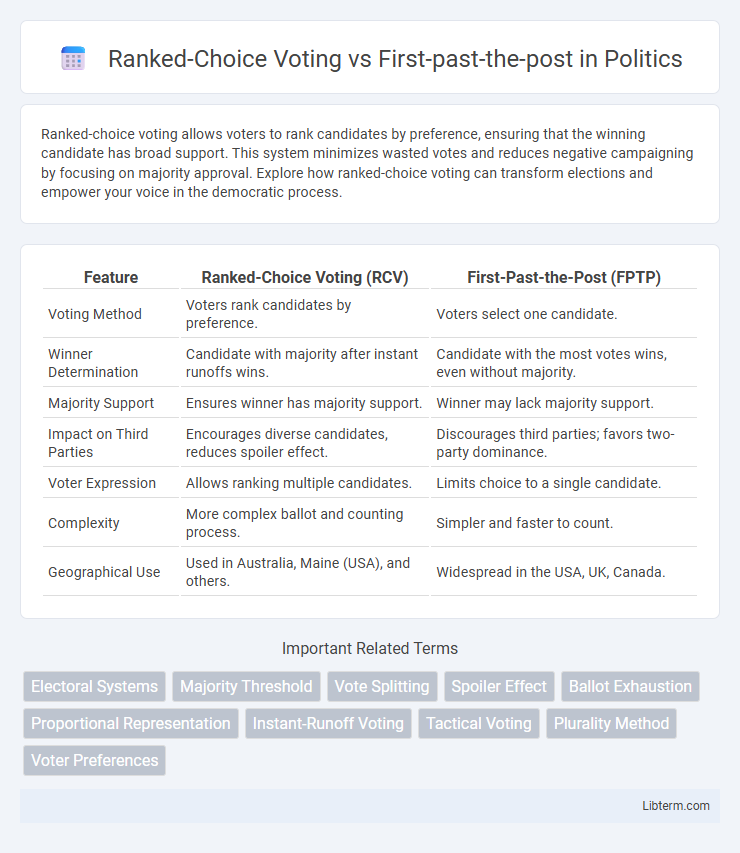Ranked-choice voting allows voters to rank candidates by preference, ensuring that the winning candidate has broad support. This system minimizes wasted votes and reduces negative campaigning by focusing on majority approval. Explore how ranked-choice voting can transform elections and empower your voice in the democratic process.
Table of Comparison
| Feature | Ranked-Choice Voting (RCV) | First-Past-the-Post (FPTP) |
|---|---|---|
| Voting Method | Voters rank candidates by preference. | Voters select one candidate. |
| Winner Determination | Candidate with majority after instant runoffs wins. | Candidate with the most votes wins, even without majority. |
| Majority Support | Ensures winner has majority support. | Winner may lack majority support. |
| Impact on Third Parties | Encourages diverse candidates, reduces spoiler effect. | Discourages third parties; favors two-party dominance. |
| Voter Expression | Allows ranking multiple candidates. | Limits choice to a single candidate. |
| Complexity | More complex ballot and counting process. | Simpler and faster to count. |
| Geographical Use | Used in Australia, Maine (USA), and others. | Widespread in the USA, UK, Canada. |
Introduction to Voting Systems
Ranked-choice voting allows voters to rank candidates by preference, promoting majority support and reducing the likelihood of vote splitting. First-past-the-post awards victory to the candidate with the most votes, often leading to a winner without majority endorsement and encouraging tactical voting. These contrasting systems impact election outcomes, voter representation, and political party dynamics significantly.
Understanding Ranked-Choice Voting
Ranked-Choice Voting (RCV) allows voters to rank candidates in order of preference, which ensures that the winning candidate has broader support by considering voters' secondary choices. This system reduces the likelihood of spoilers and strategic voting common in First-past-the-post (FPTP) elections, where the candidate with the most votes wins even without majority support. RCV promotes more representative outcomes and encourages candidates to appeal to a wider electorate beyond their core base.
Explaining First-Past-The-Post
First-Past-The-Post (FPTP) is an electoral system where the candidate with the most votes in a single-member district wins, regardless of whether they achieve an absolute majority. This plurality voting method often leads to a two-party system and can result in disproportional representation, as votes for losing candidates have no impact on the outcome. FPTP's simplicity and straightforward counting process make it widely used, but it has been criticized for marginalizing smaller parties and limiting voter choice.
How Each System Handles Majority Rule
Ranked-choice voting ensures majority rule by allowing voters to rank candidates in order of preference, redistributing votes from the least popular candidates until one achieves over 50% support. First-past-the-post declares a winner based solely on the highest number of votes, even if that candidate lacks an absolute majority, often resulting in plurality victories. This fundamental difference impacts election outcomes, with ranked-choice voting more effectively reflecting majority preferences and reducing the spoiler effect.
Impact on Voter Representation
Ranked-choice voting enhances voter representation by allowing individuals to rank candidates in order of preference, reducing the spoiler effect and promoting majority support for elected officials. First-past-the-post often results in a winner who lacks majority support, frequently marginalizing smaller parties and minority groups. Consequently, ranked-choice voting typically leads to more diverse and inclusive election outcomes that better reflect the electorate's preferences.
Effects on Political Campaign Strategies
Ranked-choice voting encourages candidates to appeal to a broader spectrum of voters, promoting coalition-building and reducing negative campaigning. First-past-the-post systems incentivize candidates to target their core base and often lead to strategic voting and polarized campaign messages. These differing electoral methods significantly shape political campaign strategies by influencing how candidates prioritize voter outreach and messaging.
Addressing Spoiler Candidates
Ranked-choice voting effectively addresses the spoiler candidate problem by allowing voters to rank candidates in order of preference, ensuring that votes for less popular candidates are redistributed until one candidate achieves a majority. This system reduces vote splitting, which often occurs in first-past-the-post elections, where a spoiler candidate can cause a preferred candidate to lose by dividing the vote. By promoting majority support, ranked-choice voting enhances electoral fairness and voter satisfaction.
Election Outcomes and Voter Satisfaction
Ranked-Choice Voting (RCV) improves election outcomes by ensuring winners have majority support, reducing the spoiler effect common in First-past-the-post (FPTP) systems where candidates can win with a mere plurality. Studies indicate RCV increases voter satisfaction by allowing expression of preferences without fear of wasted votes, leading to higher turnout and more representative results. FPTP often results in strategic voting and elected officials who lack broad appeal, which can decrease overall voter engagement and satisfaction.
Global Examples and Case Studies
Ranked-choice voting, implemented in places like Australia and Maine, allows voters to rank candidates by preference, reducing vote splitting and ensuring majority support, while first-past-the-post systems, common in the UK and India, often result in winner-takes-all outcomes that can marginalize minority voices. Studies from Ireland's use of ranked-choice voting in presidential elections show increased voter satisfaction and legitimacy of elected officials compared to the often polarizing results of first-past-the-post elections in Canada. Comparative analyses reveal that ranked-choice voting promotes more representative democracy and mitigates strategic voting, whereas first-past-the-post frequently leads to disproportionality and fewer political parties gaining power globally.
Which Voting System Is Better?
Ranked-choice voting offers a more representative outcome by allowing voters to rank candidates, reducing the spoiler effect common in first-past-the-post systems where a candidate can win without majority support. Studies show ranked-choice voting increases voter engagement, promotes majority winners, and encourages more positive campaigns. In contrast, first-past-the-post often leads to strategic voting and can marginalize minority viewpoints, making ranked-choice voting generally considered the better system for fairer, more democratic elections.
Ranked-Choice Voting Infographic

 libterm.com
libterm.com